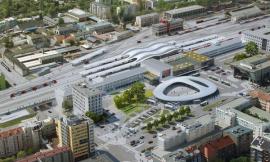MVRDV一举夺得韩国首尔中央火车站旁的废弃铁路端改造头奖。这座上世纪70年代修建,在2006年被遗弃的高架桥路段共长达938米,面积为9661平方米。设计方案为其配置了254棵树木以及各异的花草灌木,让城市更加环保,人性化,具有吸引力。
重新被利用起来的高架桥不仅美观还能为市民提供更便捷的交通,将步行时间较过去从25分钟缩短到11分钟。这座差点被拆除的高架桥受到附近居民和专家的保护,在2009年启动重生计划,在2015年开展了国际竞赛。

The Seoul Station Overpass was built in the 1970s to provide a vehicular connection from Namdaemun market, the largest traditional market in Seoul to the East, across the station area to the various parks in the West. Following intensive safety inspections in 2006, the City of Seoul deemed the 17-metre high structure of the overpass unsafe and intended to demolish and rebuild it, banning heavy vehicles’ access to the elevated roadway in 2009. Further consultation with residents and experts lead to the plan to regenerate the overpass, which totals 9.661 m2 in area, into a pedestrian walkway and public space, with the design competition launched in 2015.

MVRDV将首尔本土植物与圆形花盆结合,打造出一个独特的绿色空间;再将一系列城市公共空间活化剂要素比如茶餐厅,花店,自由市场,图书馆等植入其中,力求让场所变得更有生机与可能性。与此同时,这座美丽的天桥在蔓延的过程中还衍生出系列分支,与周边的绿地和公共空间相联系,极大的带动周边城市活力与丰富性。

Many viaducts and pedestrian overpasses in Asian cities are purely functional elements, but due to the scale of the Seoul Station Overpass which was built for vehicle traffic, an opportunity exists to create a unique public space in the heart of Seoul. The ambition to make this space as green as possible while introducing new leisure functions requires a modular and adaptable approach. MVRDV’s design creates a library of local plants, a Korean arboretum of species planted in ‘neighbourhoods’ and arranged along the 938 metre length of the Station Overpass according to their names in the Korean alphabet. In addition to the circular plant pots of varying sizes, a series of customizable activators such as tea cafés, flower shops, street markets, libraries and greenhouses will provide a catalogue of elements which will enliven the Seoul Skygarden.

In the future, the overpass will evolve with new plants and new activators so as to become an ‘urban nursery’, rearing trees for the surrounding districts. Additional structures of stairs, lifts and escalators as well as new ‘satellite’ gardens, can connect to the Skygarden, sprouting like branches from the existing structural piers. These extensions can inspire further additions to the area’s greenery and public spaces, and will connect the Skygarden to its surroundings both physically and visually through plant species related to each of the neighbourhoods. These neighbourhoods make the Skygarden easy to navigate due to their alphabetical order and consistent signage, as well as the clear differentiation between plant species in each cluster, and give a unique character to each space.



Credits:
Winy Maas, Jacob van Rijs and Nathalie de Vries with
Wenchian Shi, Kyosuk Lee, Kai Wang, Jaewoo Lee, ángel Sánchez Navarro, Antonio Luca Coco, Matteo Artico
Images: MVRDV
SEOUL SKYGARDEN - MVRDV
Facts:
Location : Seoul, South Korea
Year : 2015+
Client : Seoul Metropolitan Government
Program : Transformation of 938 metre section of elevated highway (9.661 m2) into public space
Budget : Undisclosed
Partners:
Landscape Designers : Ben Kuipers, Delft, Netherlands
Industrial Designers: Studio Makkink & Bey, Amsterdam, Netherlands
Local Architect: DMP, Seoul, Korea
Local Landscape Designer: KDI, Seoul, Korea
Structure: Saman and Cross, Seoul, Korea
Sustainability: EAN, Seoul, Korea
MEP: Samsin, Seoul, Korea
Traffic Engineers: Song Hyun R&D, Seoul, Korea
Lighting Design: Viabizzuno, Milan, Italy and Nanam Ald, Seoul Korea
App Design: nhtv, Breda, Netherlands
Cost Engineers: Myong Gun, Seoul, Korea
MORE: MVRDV |
|

 作家的避风港 WRITER’S SHED BY SURMAN WESTON
作家的避风港 WRITER’S SHED BY SURMAN WESTON
